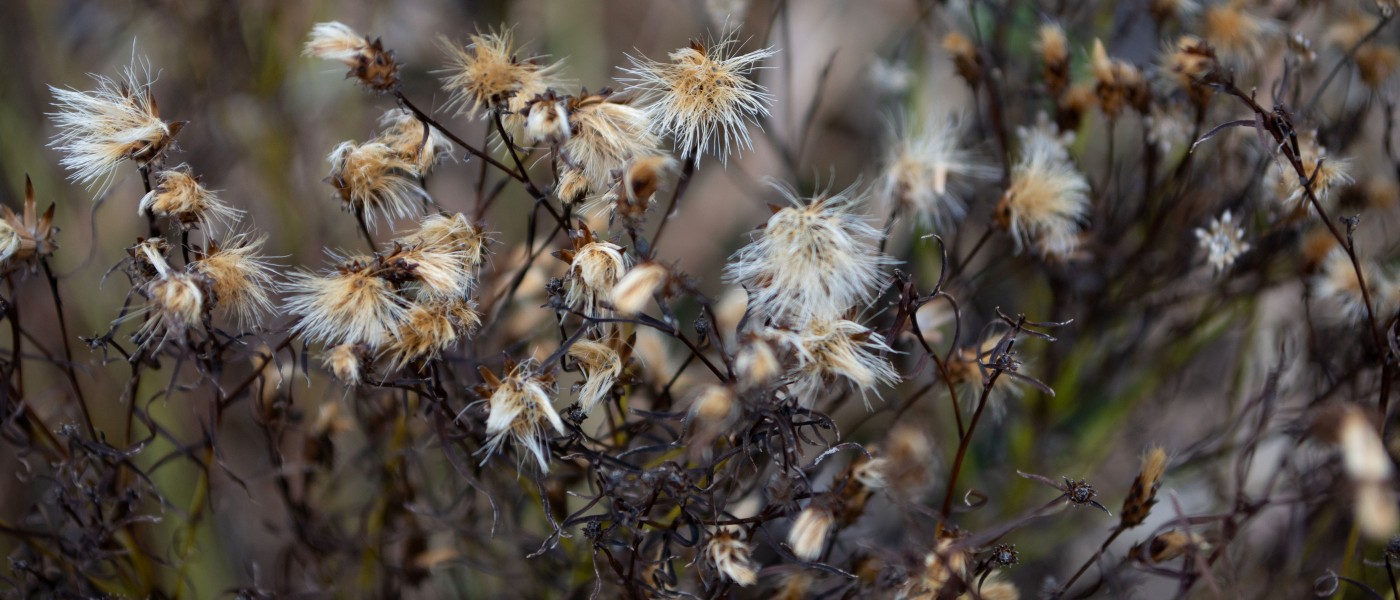Want to Feed Birds? Leave Your Perennials Standing
Life flutters along in a perennial garden, even when it’s quiet and cold. As the growing season ends, the ovaries of certain flowers mature and ripen into fruits containing seeds. The whole fruiting structure is known as an “infructescence”—a seed head. And if you refrain from cutting them back, barring a major weather event, they’ll stick around until spring.
Winter seed heads bring an additional texture to your garden, says Margarita Poulson, curator of the Water Garden. When the rain falls on dried-out seed heads, “they look like little crystals.”
Plus, leaving your native perennials uncut through the winter season can help support a wide range of insects and birds. Amid a global biodiversity crisis, which on land has been driven primarily by habitat destruction and land use, this is no trivial thing. Bird and insect populations are in alarming states of decline. Broad-scale government action is urgently needed—as nations recently agreed at the United Nations Biodiversity Conference (COP15) in Montreal—but small efforts can help, too.
“Seed heads are bird feeders on stalks, and unlike artificial bird feeders, they don’t concentrate birds as much in a way that can promote avian diseases,” says Will Lenihan, gardener of the Native Flora Garden. Many insects, too, overwinter at the bases of plants or in their hollow stems, as well as in layers of accumulated organic material, like leaf litter.
If you take a stroll through the Discovery Garden in the winter, native perennial stalks and seed heads are hard to miss. Designed as an array of immersive habitats, the Discovery Garden is meant to be a home for birds and other animals, explains Jenny Blackwell, curator of the Discovery Garden. As the weather cools, the meadow habitat becomes architectural and punctuated with fluff; missing chunks of seeds and grasses offer a signal that birds have been snacking.
“A lot of people like a more manicured approach,” says Blackwell. “But to me, this is so much more interesting.”
Lenihan recommends waiting to cut back perennials until you see pollinators flying around and temperatures are consistently around 50 degrees Fahrenheit (in the Northeast, that’s around March or April). Some stems, like those in the family Asteraceae, become even wider and more hospitable for insects if you’re able to leave them intact for multiple winters in a row.
As you plan next year’s plantings, consider including some native perennials that you can leave up throughout the winter. (And be sure to purchase plants or seeds that were not treated with pesticides.)
Below are some Brooklyn Botanic Garden staff favorites:
Aster (Symphyotrichum sp.)
Nuthatches, towhees, goldfinches, cardinals, and chickadees all feed on the seeds of aster species throughout the winter, says Lenihan. Their stems can host stem-nesting bees, and the caterpillars of the pearl crescent butterfly overwinter at the base of the smooth aster (Symphyotrichum laeve).
Joe-pye weed (Eutrocheum sp.)
Joe-pye weed is an easy wildflower for home gardeners to grow, says Poulson. In the winter, these plants offer seeds for birds and an inviting hollow stem for solitary bees and other insects. “It’s a little protection, a winter house.”
Goldenrod (Solidago sp.)
Goldenrod plants are “really one of our best bird food sources in the winter,” says Blackwell. Additionally, says Lenihan, many goldenrods will exhibit odd swellings on the stems called galls that are caused by the larvae of moths, flies, or midges living inside the stem. Birds like woodpeckers will open the galls to access vital winter protein.
Mountain mint (Pycnanthemum muticum)
Mountain mint (Pycnanthemum muticum), one of Blackwell’s favorite plants, is well-known as a pollinator magnet in the summertime. In the winter, its clustered capsules turn silvery in the frosty air.
Willowleaf sunflower (Helianthus salicifolius)
The winding shape of a bare willowleaf sunflower seed head against the sky is dramatic and memorable. Plus, the seeds of Helianthus are great winter food for chickadees, titmice, cardinals, nuthatches, and juncos, says Lenihan.
Little bluestem (Schizachyrium scoparium)
Little bluestem (Schizachyrium scoparium) is a perennial grass native to eastern North America that can attract many birds for its seeds and habitat, from buntings to common yellowthroats. Bumble bee queens also nest at the base of Schizachyrium scoparium and other bunch grasses, says Lenihan.
“Schizachyrium scoparium seed heads look particularly beautiful when planted where they can be backlit by the setting, low winter sun, which will make the seeds appear to glow,” he adds.


